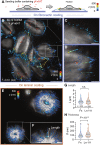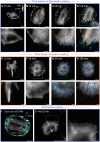Platelets drive fibronectin fibrillogenesis using integrin αIIbβ3
- PMID: 35275711
- PMCID: PMC8916723
- DOI: 10.1126/sciadv.abj8331
Platelets drive fibronectin fibrillogenesis using integrin αIIbβ3
Abstract
Platelets interact with multiple adhesion proteins during thrombogenesis, yet little is known about their ability to assemble fibronectin matrix. In vitro three-dimensional superresolution microscopy complemented by biophysical and biochemical methods revealed fundamental insights into how platelet contractility drives fibronectin fibrillogenesis. Platelets adhering to thrombus proteins (fibronectin and fibrin) versus basement membrane components (laminin and collagen IV) pull fibronectin fibrils along their apical membrane versus underneath their basal membrane, respectively. In contrast to other cell types, platelets assemble fibronectin nanofibrils using αIIbβ3 rather than α5β1 integrins. Apical fibrillogenesis correlated with a stronger activation of integrin-linked kinase, higher platelet traction forces, and a larger tension in fibrillar-like adhesions compared to basal fibrillogenesis. Our findings have potential implications for how mechanical thrombus integrity might be maintained during remodeling and vascular repair.
Figures








References
-
- Myers D. R., Qiu Y., Fay M. E., Tennenbaum M., Chester D., Cuadrado J., Sakurai Y., Baek J., Tran R., Ciciliano J. C., Ahn B., Mannino R. G., Bunting S. T., Bennett C., Briones M., Fernandez-Nieves A., Smith M. L., Brown A. C., Sulchek T., Lam W. A., Single-platelet nanomechanics measured by high-throughput cytometry. Nat. Mater. 16, 230–235 (2017). - PMC - PubMed
-
- Nurden P., Nurden A. T., Congenital disorders associated with platelet dysfunctions. Thromb. Haemost. 99, 253–263 (2008). - PubMed
-
- Nicolai L., Schiefelbein K., Lipsky S., Leunig A., Hoffknecht M., Pekayvaz K., Raude B., Marx C., Ehrlich A., Pircher J., Zhang Z., Saleh I., Marel A. K., Löf A., Petzold T., Lorenz M., Stark K., Pick R., Rosenberger G., Weckbach L., Uhl B., Xia S., Reichel C. A., Walzog B., Schulz C., Zheden V., Bender M., Li R., Massberg S., Gaertner F., Vascular surveillance by haptotactic blood platelets in inflammation and infection. Nat. Commun. 11, 5778 (2020). - PMC - PubMed
LinkOut - more resources
Full Text Sources

